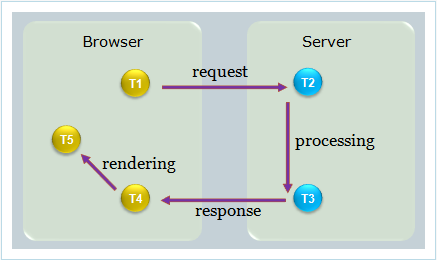Performance Meters"
From Documentation
| Line 18: | Line 18: | ||
* Network Latency Time: (T4 - T3) + (T2 - T1) | * Network Latency Time: (T4 - T3) + (T2 - T1) | ||
| + | = How it works = | ||
Notice that, when we make a connection to load a page for the first time, only Server Execution Time is available. T4 and T5 will be saved on the client-side and sent back along with the next request. | Notice that, when we make a connection to load a page for the first time, only Server Execution Time is available. T4 and T5 will be saved on the client-side and sent back along with the next request. | ||
| + | |||
| + | If you print the request ID and the method name, when zk calls a performance monitor. You will see a different log between loading a zul and sending an AU request. | ||
| + | |||
| + | == Request a ZUL == | ||
| + | If load a zul 3 times: | ||
| + | <syntaxhighlight lang='md'> | ||
| + | # first load zul | ||
| + | requestId1st - requestStartAtServer | ||
| + | requestId1st - requestCompleteAtServer | ||
| + | |||
| + | # 2nd load zul | ||
| + | requestId1st - requestReceiveAtClient | ||
| + | requestId1st - requestCompleteAtClient | ||
| + | requestId2nd - requestStartAtServer | ||
| + | requestId2nd - requestCompleteAtServer | ||
| + | |||
| + | # 3rd load zul | ||
| + | requestId2nd - requestReceiveAtClient | ||
| + | requestId2nd - requestCompleteAtClient | ||
| + | requestId3rd - requestStartAtServer | ||
| + | requestId3rd - requestCompleteAtServer | ||
| + | </syntaxhighlight> | ||
= Register as a Listener = | = Register as a Listener = | ||
Revision as of 07:13, 8 July 2022
PerformanceMeter is a collection of callbacks that the implementation could know when a request is sent, arrives or is is processed.
As shown above, T1-T5 identifies the following callbacks.
- T1: PerformanceMeter.requestStartAtClient (String, Execution, long)
- T2: PerformanceMeter.requestStartAtServer(String, Execution, long)
- T3: PerformanceMeter.requestCompleteAtServer(String, Execution, long)
- T4: PerformanceMeter.requestReceiveAtClient(String, Execution, long)
- T5: PerformanceMeter.requestCompleteAtClient(String, Execution, long)
Thus,
- Server Execution Time: T3 - T2
- Client Execution Time: T5 - T4
- Network Latency Time: (T4 - T3) + (T2 - T1)
How it works
Notice that, when we make a connection to load a page for the first time, only Server Execution Time is available. T4 and T5 will be saved on the client-side and sent back along with the next request.
If you print the request ID and the method name, when zk calls a performance monitor. You will see a different log between loading a zul and sending an AU request.
Request a ZUL
If load a zul 3 times:
# first load zul
requestId1st - requestStartAtServer
requestId1st - requestCompleteAtServer
# 2nd load zul
requestId1st - requestReceiveAtClient
requestId1st - requestCompleteAtClient
requestId2nd - requestStartAtServer
requestId2nd - requestCompleteAtServer
# 3rd load zul
requestId2nd - requestReceiveAtClient
requestId2nd - requestCompleteAtClient
requestId3rd - requestStartAtServer
requestId3rd - requestCompleteAtServer
Register as a Listener
Once implemented, you need to register it as a listener in WEB-INF/zk.xml to make it work: (assume the class is called foo.MyMeter):
<listener>
<listener-class>foo.MyMeter</listener-class>
</listener>
